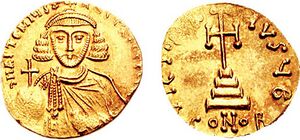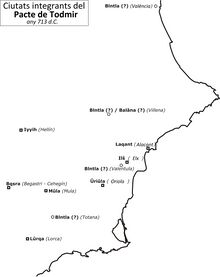713
| القرون: | قرن 7 · قرن 8 · قرن 9 |
| العقود: | ع680 ع690 ع700 ع710 ع720 ع730 ع740 |
| السنوات: | 710 711 712 713 714 715 716 |
| ألفية: | الألفية 1 |
|---|---|
| قرون: | القرن 7 – القرن 8 – القرن 9 |
| عقود: | عقد 680 عقد 690 عقد 700 – عقد 710 – عقد 720 عقد 730 عقد 740 |
| سنين: | 710 711 712 – 713 – 714 715 716 |
| 713 حسب الموضوع | |
| السياسة | |
| زعماء الدول – الدول ذات السيادة | |
| تصنيفات المواليد والوفيات | |
| المواليد – الوفيات | |
| تصنيفات التأسيسات والانحلالات | |
| تأسيسات – انحلالات | |
| التقويم الگريگوري | 713 DCCXIII |
| آب أوربه كونديتا | 1466 |
| التقويم الأرمني | 162 ԹՎ ՃԿԲ |
| التقويم الآشوري | 5463 |
| التقويم البهائي | −1131 – −1130 |
| التقويم البنغالي | 120 |
| التقويم الأمازيغي | 1663 |
| سنة العهد الإنگليزي | N/A |
| التقويم البوذي | 1257 |
| التقويم البورمي | 75 |
| التقويم البيزنطي | 6221–6222 |
| التقويم الصيني | 壬子年 (الماء الفأر) 3409 أو 3349 — إلى — 癸丑年 (الماء الثور) 3410 أو 3350 |
| التقويم القبطي | 429–430 |
| التقويم الديسكوردي | 1879 |
| التقويم الإثيوپي | 705–706 |
| التقويم العبري | 4473–4474 |
| التقاويم الهندوسية | |
| - ڤيكرام سامڤات | 769–770 |
| - شاكا سامڤات | 635–636 |
| - كالي يوگا | 3814–3815 |
| تقويم الهولوسين | 10713 |
| تقويم الإگبو | −287 – −286 |
| التقويم الإيراني | 91–92 |
| التقويم الهجري | 94–95 |
| التقويم الياباني | Wadō 6 (和銅6年) |
| تقويم جوچى | N/A |
| التقويم اليوليوسي | 713 DCCXIII |
| التقويم الكوري | 3046 |
| تقويم مينگوو | 1199 قبل جمهورية الصين 民前1199年 |
| التقويم الشمسي التايلندي | 1256 |
Year 713 (DCCXIII) was a common year starting on Sunday (link will display the full calendar) of the Julian calendar. The denomination 713 for this year has been used since the early medieval period, when the Anno Domini calendar era became the prevalent method in Europe for naming years.
أحداث
حسب المكان
الامبراطورية البيزنطية
 Emperor Anastasios II (713–715) |
- June 3 – Emperor Philippicus is blinded، deposed, and sent into exile by conspirators of the Opsikion army in Thrace، after a reign of 1 year and 6 months. He is succeeded by Anastasios II، a bureaucrat and imperial secretary, who restores internal order and begins the reorganization of the Byzantine army. He executes the officers who have been directly involved in the conspiracy against Philippicus.
- Arab–Byzantine wars: The Umayyad Arabs under al-Abbas ibn al-Walid، son of caliph al-Walid I، sack Antioch in Pisidia (modern Turkey), which never recovers.
بريطانيا
- King Ealdwulf of East Anglia dies, and is succeeded by his son Ælfwald. Queen Cuthburh of Northumbria travels south to found a monastery at Wimborne (Dorset).
الدولة العربية
- 28 فبراير - زلزال في الشام.
 المدن التي تناولتها معاهدة تودمير. |
- الفتح الأموي لهسپانيا: مملكة القوط الغربيين is finally defeated at the Battle of Segoyuela (Castile and León). Prince Theudimer signs the Treaty of Orihuela with Abd al-Aziz، governor of Al-Andalus، and is permitted to retain his authority in the area subsequently known as Tudmir. He keeps the citadel of Orihuela and several other settlements, including Alicante and Lorca on the Mediterranean Sea.[1]
- Arab forces under Musa ibn Nusayr conquer the fortress city of Mérida، located on the borders of Andalusia. It becomes part of the Umayyad إمارة قرطبة.
- العرب يصلون نهر السند. محمد بن القاسم يستولي على ملتان، مما يجعله سيداً على السند. Prisoner soldiers were beheaded, but Hindus and Buddhists were assimilated to dhimmis ("protected"), and could retain their religion by paying the jiziya .
الصين
- Emperor Xuan Zong liquidates the highly lucrative "Inexhaustible Treasury", which is run by a prominent Buddhist monastery in Chang'an. This monastery collects vast amounts of money, silk، and treasures through multitudes of rich people's repentances, left on the premises anonymously. Although the monastery is generous in donations, Xuan Zong issues a decree abolishing their treasury, on the grounds that their banking practices were fraudulent, collects their riches, and distributes the wealth to various other Buddhist monasteries, Daoist abbeys, and to repair statues, halls, and bridges in the city.
- In Chang'an، for the annual Lantern Festival of this year, recently abdicated emperor Rui Zong erects an enormous lantern wheel at a city gate، with a recorded height of 200 ft. The frame is draped in brocades and silk gauze، adorned with gold and jade jewelry, and when its total of some 50,000 oil cups is lit, the radiance of it can be seen for miles.
- Xuan Zong allots the money of 20 million copper coins, and assigns about 1,000 craftsmen to construct a hall at a Buddhist monastery with tons of painted portraits of himself, and of deities, ghosts, etc.
- Xuan Zong wins a power struggle with his sister, Princess Taiping. He executes a large number of her allies and forces her to commit suicide.
- أقدم صحيفة في العالم، وهي صحيفة تشينغ ياو الصينية تصدر لأول مرة.
حسب الموضوع
الأدب
- During the Tang Dynasty، publication of Kaiyuan Za Bao ("Bulletin of the Court"). First newspaper، hand printed on silk (approximate date).
الدين
- بعد وفاة رابع الأئمة علي زين العابدين، حدث إنشقاق في الشيعة: الزيديون (الشيعة الخمسية) اختاروا زيد بن علي إماماً لهم، بينما الإسماعيليون (الشيعة السبعية) والاثناعشرية اختاروا محمد الباقر.
- بدء إنشاء بوذا الكبير في لىشان بالقرب من لىشان، Sichuan Province (الصين). Upon its completion in 803، it will become the largest stone carved Buddha in the world. At 71 meters high, it is still the world's largest stone sculpture of a Buddha . It is carved out of a rock at the confluence of the Min Jiang , Dadu and Qingyi rivers near the city of Leshan in the southern part of Sichuan province in China , during the Tang Dynasty . The Buddha faces Mount Emei Shan , one of the four sacred Buddhist mountains, while the rivers spread at his feet. With the construction, Haitong hopes to calm the troubled waters that have affected navigation on the rivers.
مواليد
- الليث بن سعد، فقيه مسلم.
- كارلومان، عمدة القصر للفرنجة (تاريخ تقريبي)
- Stephen the Younger، Byzantine theologian (أو 715)
- Zhang Xuan، Chinese painter (ت. 755)
وفيات
- علي زين العابدين، رابع أئمة الشيعة وابن حفيد سيدنا محمد.
- أبو بيهس، فقيه بالمدينة المنورة. (ru:Абу_Байхас)
- Ealdwulf، ملك شرق أنگليا
- Huineng، Chinese Zen Buddhist patriarch (و. 638)
- Li Jiao، chancellor of the Tang Dynasty (و. 644)
- Philippicus، Byzantine emperor
- Taiping، princess of the Tang Dynasty
- Suitbert، Anglo-Saxon missionary bishop
- Ursmar، Frankish abbot and missionary bishop
- Yijing، Chinese Buddhist monk and traveler (و. 635)
المراجع
- ^ David Nicolle (2008). Poitiers AD 732, Charles Martel turns the Islamic tide (p. 17). ISBN 978-184603-230-1
This article contains content from Wikimedia licensed under CC BY-SA 4.0. Please comply with the license terms.
